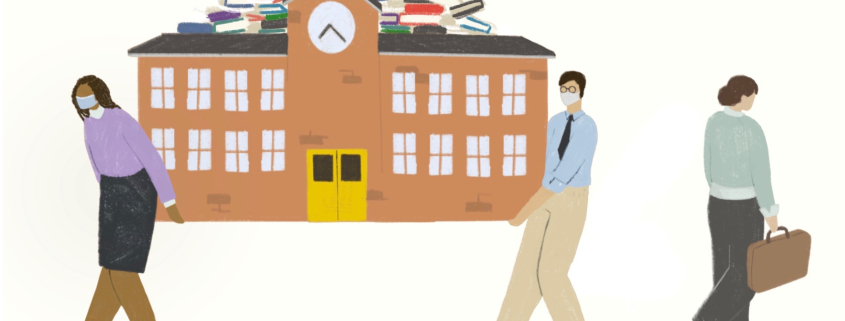We can’t blame teachers for leaving their profession

School districts across the nation, especially those in low-income communities, faced severe teacher shortages even before the pandemic. Something about incurring massive debt for a career of backbreaking hours and a heartbreaking lack of respect just doesn’t do it for some. But just when teachers across the United States uttered a collective, “this can’t possibly get worse,” the pandemic brought on a new slew of hurdles.
Safety concerns, difficulties teaching online and constantly changing coronavirus guidelines put undue pressure on teachers to juggle insurmountable requirements for meager pay. During the lockdowns, the many problems work-from-home workers faced — lack of childcare and the threat of a deadly virus, among others — made teaching somehow even more impossible than before.
More recently, several school districts have begun to tout laxed safety protocols and removed their mask bans, which add a biochemically hazardous spice to the struggles of being a teacher. Unsurprisingly, teachers are leaving their jobs in droves — and can we blame them?
An estimated 800,000 public school teachers quit their jobs between January and November 2021 across the nation. A recent poll conducted by the National Education Association indicates that 55% of current teachers are considering doing the same.
Where teachers’ unions and politically galvanized school boards couldn’t provide the support needed, TikTok and Instagram stepped up. Social media hashtags like #TeachersLeavingEd and #CareersForTeachers helped teachers find alternative jobs and provided a sense of community considering leaving the profession. Promises of better pay, potential for career growth and better work-life balance have motivated teachers to take jobs in tech, health, sales and more, and many aren’t looking back.
Their ability to communicate new knowledge and long-attested patience make former teachers valuable assets to their new employers. Many note that they are more respected in their new positions, despite finding leaving the classroom emotionally wrenching.
It looks like the “Best Teacher Ever!” mugs aren’t doing much to secure the sanity of teachers across America. Hearing parents exclaim, “Gosh! I don’t know how you do it!” to the teacher of their kid — who definitely chased the rest of us with scissors — proves my point. How are teachers expected to do it all?
Endless benchmark exams to pressure from parents and superiors are just a few of the challenges teachers must grapple with. Even more so, fault for the institutional failures of the education system unjustifiably falls squarely on teachers’ shoulders.
Is it really any wonder why fewer and fewer young people want to teach?
While many former teachers have left behind crowded, poorly ventilated classrooms for good, their exodus creates countless ramifications for students. Indeed, the classrooms teachers leave behind are looking increasingly dystopian-war-movie-meets-Sesame Street.
In wake of omicron-driven teacher shortages, desperate school districts got crafty with who they sat behind the desk. Whereas long-retired teachers make logical substitutes, New Mexico’s governor recently announced an initiative to station National Guard members in classrooms to, you know, teach. Further, the issues plaguing America’s education system are even worse when coupled with a growing lack of qualified, consistent teachers.
In California, four in every five school districts face a teacher shortage, with a majority of affected districts representing low-income communities or communities of color. To keep schools open, many districts are certifying unqualified educators.
If these trends continue, we could be looking at perpetuated disparities in the quality of education between affluent communities and those most affected by shortages in the long term. In the Los Angeles Unified School District alone, there are 500 teaching vacancies. The prospects of filling them don’t look too good, as the conditions have not improved — especially considering that more schools are returning to in-person instruction at the height of the Omicron variant.
These issues don’t stop at K-12. Professors across the nation are resigning because their universities refuse to do more to limit the spread of coronavirus. While teachers at the university level aren’t quitting in droves like they are in elementary and secondary education, the lack of vaccination requirements and mask mandates have faculty at higher education institutions concerned.
Look, I’m not completely down with the idea of the military descending on our local seventh grade classes to teach English like what occurred in New Mexico earlier this month, nor am I stoked about teachers having to trade their teaching passion for a realistic way to feed their families. This teacher shortage is a grave reflection of our inability to support teachers, the very people who get us where we are today. For every handful of teachers leaving their professions for good, there’s a Rossier student who definitely doesn’t need to hear, “You know what you’re getting into, right?” again — because good teachers truly make a difference.

